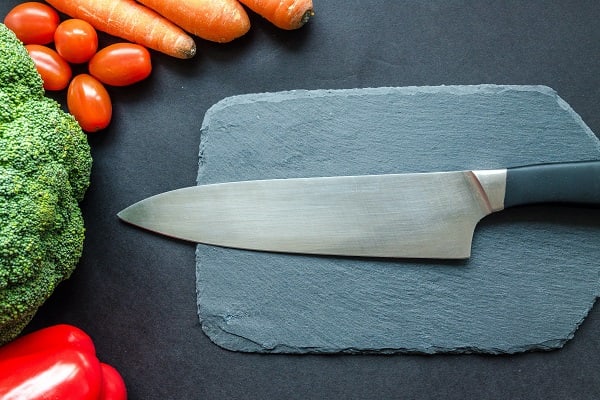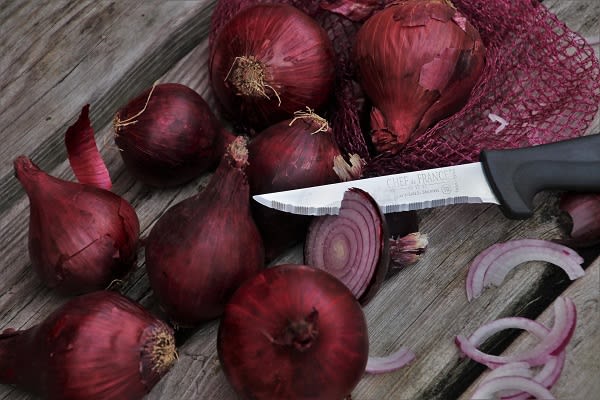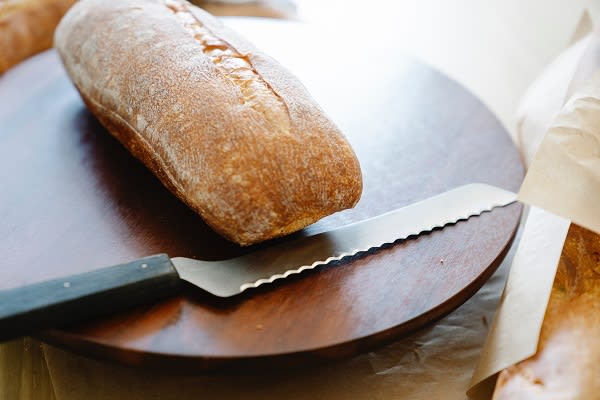What Are the Different Types of Kitchen Knives?
What Are the Different Types of Kitchen Knives?
Kitchen Knives 101
Kitchen knives are one of the few tools you’ll use virtually every time you prepare food. That doesn’t mean you need to invest in an expensive set of knives—or even a single expensive knife. But what it does mean is that before you buy kitchen knives or upgrade from what you already have, you should know the basics of different types of kitchen knives.
The Big 3: Chef’s Knife, Paring Knife, Serrated Knife
Despite the numerous slots on the knife blocks you might see on people’s kitchen counters, there are really only three types of kitchen knives that you truly need: a chef’s knife, a paring knife, and a serrated knife. If you’re a blade lover, you can always expand your collection, but this trio will get you through pretty much any kitchen sitch. And no matter the size of your collection, make sure that your knives are sharp—using a dull knife will put you on the fast track to bandaged fingers.

1. Chef’s Knife
Its title reflects its essence: a multipurpose knife that no chef could go without. A chef’s knife is long—usually with an 8- to 10-inch metal blade, though you can find chef’s knives with blades anywhere from 6 to 14 inches—and broad at the base, tapering to a fine point at the end. Its blade is gently curved, enabling the user to rock the knife back and forth to mince or chop items. A chef’s knife is most likely the knife you’ll turn to the most. The broad base of the blade lets it cut sturdy foods such as potatoes, while the tapered tip means it can handle finer cuts too. You can also turn the blade on its side and use its width to crush, say, garlic cloves.Chef’s knives are one of the most personal items in a professional cook’s knife roll—and it’s not all that different for the home cook, either. What’s perfect for one cook might never feel comfortable to another. When selecting a chef’s knife, evaluate how it fits in your hand when you hold it. If it feels awkward in your grip, keep trying different knives until you find one that you can hold comfortably. Some people prefer a heavy handle to provide more heft and stability, while others prefer a lighter-weight tool.

2. Paring Knife
A paring knife looks like a miniature chef’s knife: a handle supporting a gently curved blade that tapers to a fine point. Paring knives have a shorter, narrower blade than their chef’s knife counterparts, usually 2 to 5 inches. And while they can be used for some of the same tasks as a chef’s knife, the paring knife takes center stage when it comes to handling small or delicate items, as its smaller dimensions make it easier to maneuver. (Ever tried to hull a strawberry with an 8-inch blade? Neither has anyone else.) And true to its name, it’s great for paring fruits and vegetables as well, allowing you to remove the skin of produce efficiently. Learn how to use a paring knife correctly, and you might never use your peeler again.As with a chef’s knife, the right paring knife for one person might not be great for someone else. While you don’t need to spend a king’s ransom to get quality knives of any type, paring knives in particular are known for being budget-friendly—you can get a decent paring knife for $10, though pricier versions may last longer (and look flashier).

3. Serrated Knife
A serrated knife has “teeth” along the edge of the blade, like a saw. Longer serrated knives in the 8- to 12-inch range may be sold as “bread knives.” The teeth of serrated knives allow them to cut into softer items (yes, such as bread) without tearing the food in ways you don’t want it torn. In addition to being useful for slicing bread, they’re useful for cutting delicate items such as tomatoes and pastries. They’re good for cutting into cakes, too—and the serrated edge can also be used to comb the edge of a cake decorated with buttercream frosting, giving an attractive ribbed finish.Smaller serrated knives with blades under 8 inches can be used to cut into smaller delicate items—and if you like the look of them, they can pull double duty at your dinner table as steak knives.
Other Important Knives in the Kitchen
Similar to a chef’s knife in its purpose, a santoku knife has a thinner blade, so it’s lighter in the hand. This makes a santoku knife, which originated in Japan, helpful in more precise cutting.
Another Japanese invention, the nakiri knife is made specifically for cutting vegetables. It has a rounded or blunt tip, not a sharp tip, and is great for chopping straight up and down (unlike the rocking motion that chef’s knives are made for).
A large, heavy knife, usually with a hole toward the end, a cleaver is designed to cut into large cuts of meat and other tough items. Its blade is wider than a butcher’s knife.
Like a cleaver, a butcher’s knife is designed for cutting meat. But its smaller, narrower blade allows for more precise cutting.
As with a chef’s knife and paring knife, this knife’s purpose is in its name—it does a lot of things pretty well. It’s sort of the middle ground between a chef’s knife and a paring knife, with a blade that’s usually around 6 inches.
This long, thin knife is designed to strip meat from the bone. While it’s strong, it’s also flexible thanks to its thinness, though there are also stiff boning knives that are helpful for thicker cuts of meat.
Similar to a boning knife, a filleting knife features a blade that is definitively flexible. This allows the chef to navigate the fine bones involved with fish fillets.